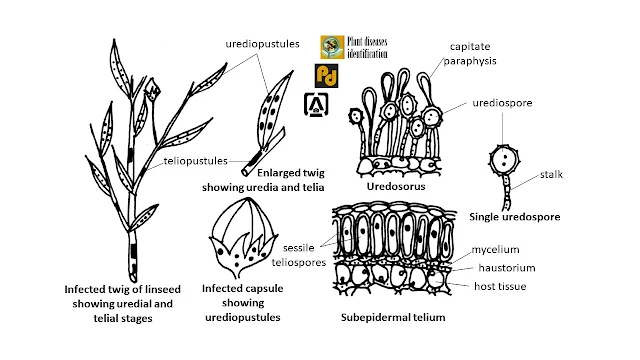Rust of linseed
Host: Linum usitatissimum (Linseed)
Pathogen: Melampsora lini (Pers.) Lév.
Pathogen: Melampsora lini (Pers.) Lév.
Distribution
Rust of linseed is a common disease in Bihar and Bundelkhand region of Uttar Pradesh. Beside this, the disease is also reported from other states of India, where the crop is grown. Rust of linseed is also reported from North and South America, Europe, Africa, Asia and Australia.
In India, linseed is an oil seed crop and grown between October to April. Rust disease generally appears after February, but Butler (1918) reported this disease in November in Central India.
In India, linseed is an oil seed crop and grown between October to April. Rust disease generally appears after February, but Butler (1918) reported this disease in November in Central India.
Symptoms
Early symptoms appear in the form of bright-orange colored pustules on the leaves, which are surrounded by chlorotic areas (yellow halo). These pustules are uredosori containing uredospores. Very soon the stems and fruits are covered with uredopustules and symptoms become conspicuous.
At the end of growing season, dark brown to black colored teleutopustules containing teliospores are seen on the stem surrounding older uredopustules. Teleutopustules do not break the epidermis of the host and remain subepidermal appearing glossy.
At the end of growing season, dark brown to black colored teleutopustules containing teliospores are seen on the stem surrounding older uredopustules. Teleutopustules do not break the epidermis of the host and remain subepidermal appearing glossy.
Causal organism
The disease is caused by Melampsora lini (Pers.) Lév. The mycelium is intercellular, dikaryotic, branched, septate and grows in the parenchymatous tissue of the host. Pathogen produces uredospores, teliospores, pycniospores and aeciospores in a single host only. Therefore, M. lini is an autoecious rust. In India, only uredospores and teliospores occur.
 |
| Diagram showing various of stages of disease cycle of rust of linseed caused by Melampsora lini |
Disease cycle and epidemiology
In India, the disease is air-borne. As linseed is grown in the winter season, uredospores as well as teliospores have to over-summer. However both the spores can not survive the scorching heat of summer and die. According to Prasada (1948), uredospores and teliospores survive in the hills grown above 7,000 and 4,000 feet above sea level. Accordingly, linseed in the hills get infected first. Fresh uredopsores produced in the hills are blown by the wind and cause primary infection in the plains. Uredospores from the infected plants act as secondary inoculum and cause heavy damage.
Control measures
- The only method to control the disease is to grow resistant varieties. Some of the rust resistant varieties of linseed are Surya (LCK-1404), JLS-95, Uma (LCK-1101), Indu (LCK-1108), SLS-73 (JLS-73), Jawahar Linseed-41 (PKDL-41). (Source: Anonymous, 2022)
- Application of excess dose of nitrogenous fertilizer should be avoided.
Sources
- Anonymous, 2022. https://oilseeds.dac.gov.in/Linseed.aspx accessed on 11 December 2022.
- Prasada, R., 1948. Studies in linseed rust, Melampsora lini (Pers.) Lév. in India. Indian Phytopathol., 1, pp.1-18.
Content first created on 11-12-2022
last updated on 12-12-2022
last updated on 12-12-2022






0 Comments
Leave your comments here.